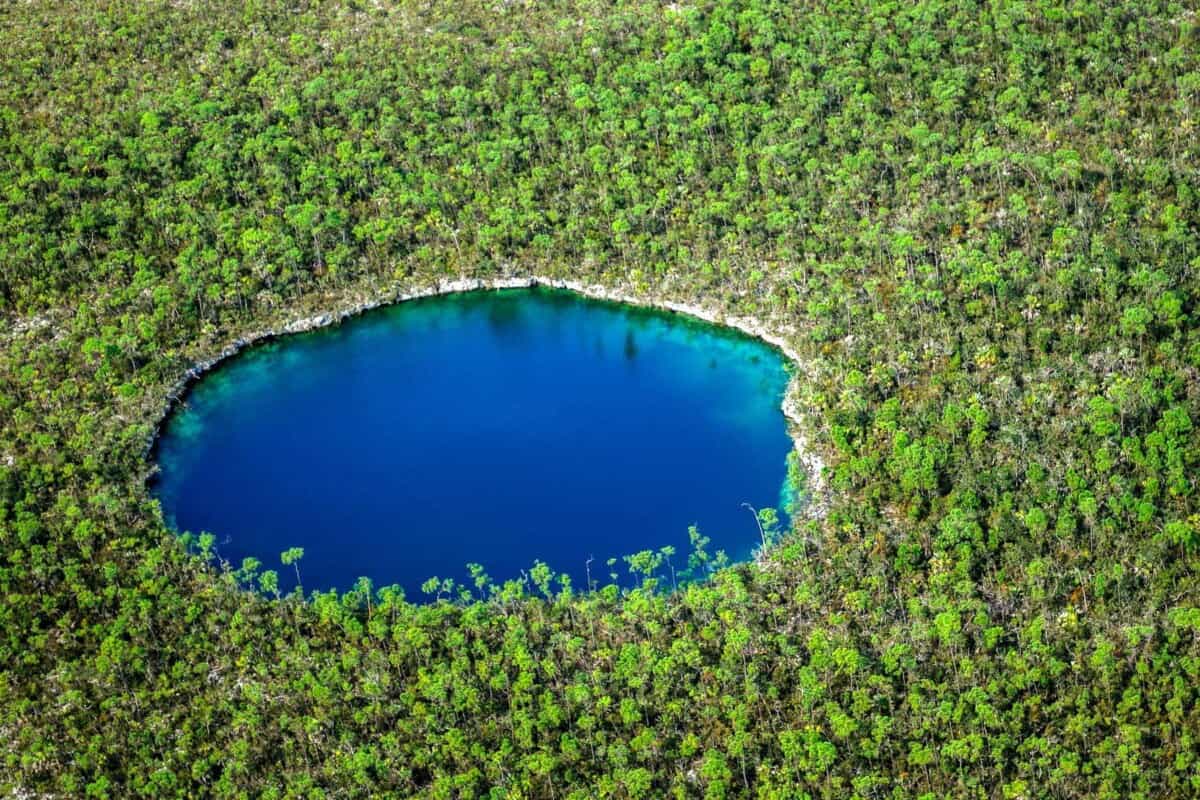As a diver who loves adventure and admires unique experiences, I wanted to find out where the best blue holes are. After tons of research combined with personal dive trips, I compiled a list of the best divable blue holes.
Blue holes are sinkholes or former caves that became flooded. Most are very old and date back over 150,000 years ago. Blue holes occur in both the ocean and on land.
Let’s get into the list with number 1 being the very best of the best. Keep reading to find out who won the top spot.
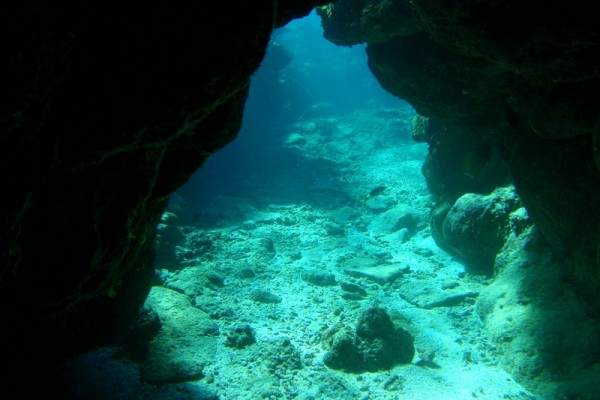
11.) Pozzo Del Merro
Mentana, Italy
Expect to see: cave, limestone formations, water plants
This inland blue hole is 1,286 feet (392 m) deep and wasn’t officially measured until 2003.
The sinkhole was first explored by divers in 1999 and research is ongoing at the site. Scientific studies have researched how diving depth affect the psychological and physiological state of divers. Other studies include microorganisms, bacteria, and native plant growth.
A mesmerizing layer of water plants covers the top of the water. The dive starts off with poor visibility which gets better with more depth. Eventually, visibility is excellent.
There is a staircase along the edge of the sinkhole for easy access.
Divers who are certified can explore the cave system and dive at deeper depths. Always be cautious and maintain depth awareness.
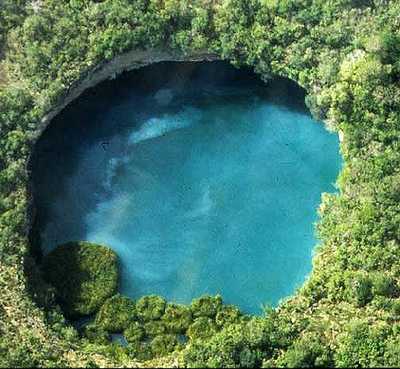
10.) El Zacaton
Aldama, Tamaulipas, Mexico
Expect to see: floating islands, colorful microorganisms, limestone wall
The Zacaton is one of the deepest freshwater sinkholes on earth. It’s 1,099 feet (335 m) deep and 361 feet (110 m) wide. The sinkhole was created by erosion due to volcanic activity.
It’s been a popular diving location since the late 80s. Several diving world records have been set here including a woman’s world record in 1993 and a men’s world record in 1994.
The main attraction of this hole is the depth of it, the fact that it contains freshwater, and free-floating islands within the sinkhole. These islands are very unique and move through the sinkhole depending on wind patterns. The sizes of the islands range from 10-33 feet (3-10 m).
11 of the Most Unique Places to Dive in Mexico
The water is between 84-86 F (29-30 C), slightly sulfurous, and contains high amounts of minerals. There are communities of microorganisms in various colors including red, purple, and green.
The hole was researched and funded by NASA in 2007 by a newly developed robot. The robot (DEPTHX) was built for exploring Jupiter’s moon but using it at the Zacaton was a great opportunity to tests its endurance. The robot consists of over 100 sensors and is able to swim through the water using thrusters.
The robot is the size of a go-kart and was able to collect many samples of the water, walls, bacteria, and was even able to map the hole.

9.) Santa Rosa Blue Hole
Santa Rosa, New Mexico, USA
Expect to see: cave
This 80 feet (24 m) deep hole seems to be perfectly placed in the middle of almost nothing. It’s a wonderful place for swimming and diving as well. With cool clear waters and a great underwater cave system to explore.
The surface of the hole is 80 feet (24 m) wide and it expands to 130 feet (40 m) at the bottom. The dive is at a high altitude (4,616 ft/ 1,407 m) so dive times should be adjusted accordingly.
The site is an artesian well that was once used for fish hatching. Now, it’s a haven in the middle of a semi-desert climate. The hole is a popular swimming site and is regularly used for scuba diving and scuba training.
This hole is ranked top 10 swimming holes in the USA. The water might be cold for people since it’s almost always 60-65 F (16-18 C). The water is always clear but the best visibility is in the morning before 10 am.
There aren’t too many fish to see but the cave system is really nice and it’s a perfect spot for all levels of divers.
There is even said to be an annual underwater pumpkin carving contest hosted in October.
There is not always a lifeguard on duty and there has been a death at the site. This was due to a diver attempting to explore the cave system and getting lost and drowning. Always be aware of your depth and skill level.
Each diver must purchase a diving permit valid for one week with annual passes also available. There is a dive shop on-site for rentals, information, maps, and guides. Paid parking, public restrooms, and changing areas are also on site.

8.) Blue Holes
Koror, Palau
Expect to see: coral, reef walls, caves, tropical fish, giant clams, barracuda, tuna, sharks, rays
Blue Holes in Palau is actually a site with four connecting holes within a reef system. It’s by far the best dive in all of Palau and certainly the most fun.
Divers usually enter through the main hole and make their way down to the bottom at 120 feet (37 m). Taking in the sights and exploring all the small crevices. From the main hole, there are 2 exit points. One is referred to as the ‘window‘ at 45 feet (14 m) deep and the other is a larger opening at 85 feet (26 m) depth.
Both exit points are filled with lots of fish, sharks, coral, and reef systems to explore. They lead divers onward to a nearby site called Blue Corner which is a diverse reef wall filled with over 1,400 species of fish, 700 species of coral, and 7 species of giant clams. You definitely want to visit Blue Corner.
You might be wondering about the fourth hole. That hole is off the main entry point at 80 feet (24 m) deep and leads to the entrance to another cave. It’s such a narrow opening that you won’t confuse it with the other wider exit hole nearby.
This narrow passageway leads to the ‘Temple of Doom‘. As the name might suggest it is a dangerous cave for uncertified divers and should not be explored unless you are adequately trained in cave diving. There have been deaths here due to untrained divers attempting to explore the Temple of Doom.
Visibility ranges from 60-150 feet (18-46 m) which changes due to varying current patterns.
The currents change frequently in the area, especially around Blue Corner. These currents can sometimes be very strong so be mindful of this especially if you are a beginner.

7.) Gozo Blue Hole
Dwerja, Malta
Expect to see: parrotfish, grouper, lobster, eel, octopus, coral, cave, tunnels, swim-throughs
Easily the most famous dive site in Malta and certainly one of the most beautiful. The Blue Hole in Dwerja is a limestone sinkhole (197 ft /60 m deep) right along the coastline. An arched rock formation called Azure Window once hung over the blue hole but was knocked down during a storm in 2017.
Entering the water is relatively easy once you get to the location. Divers enter the area and slowly walk out to deeper waters. Once descending there are lots of large boulders directly below the entrance. These are the remains of Azure Window from when it collapsed during a storm.
The boulders have created a new reef system so there is a lot to explore and swim around. To the side, there is a cave that can be entered if you are experienced.
There are lots of swim-throughs and tunnels wide enough for one diver at a time. Schools of tiny tropical fish frequent the area especially near the coral garden.
The site is open year-round and also great for swimmers, freedivers, and snorkelers.
Since the dive site is directly off the coastline it’s a popular tourist attraction. It gets really busy in the afternoon so the earlier the better if you want to avoid the crowds.
Divers gear up nearby and walk 5-10 minutes along with going down steps. It can get slippery so mind your footing and wear sandals or swim shoes.

6.) Blue Holes of Abaco
Great Abaco, Bahamas
Expect to see: caves, caverns, stalactites, lobster, clams, crabs, reef fish, barracuda
At least 50,000 feet of underwater cave systems have been officially discovered and surveyed on Great Abaco Island. The island contains many blue holes with most of which are on land.
There are tones of blue holes to explore but here are some of the top places worth checking out.
Nancy’s Blue Hole is near Cooperstown has the largest speleothem cave formations in the Bahamas. The hole is located in a mangrove and the waters are crystal clear.
Far Side Blue Hole (Magical Blue Hole) is 334 (102 m) feet deep with waters that are almost invisible. It’s truly breathtaking.
Reel Breaker is located on the east side of the island and is only 100 feet (30 m) from the shore. The passageways of large cave formations are lined with a dense layer of colorful sea sponges and tunicates.
Dan’s Blue Hole contains mesmerizing stalactites and limestone formations with the oldest formation at this site dating back 350,000 years ago. This site is massive and extensively visited for the sake of mapping and exploring. Dan’s contains many passageways to other nearby caves. Dives here are regulated to help preserve the site.
Guardian Blue Hole gets its name from the barracuda that “guard” the entry point. Really, they just hang out so don’t mind them. The freshwater turns salty the deeper you go and the stalactites are incredible.
Treasure Cay is 254 feet (77 m) deep and an inland hole. It’s known to not have any or much marine life but the cave system is great for exploring.
Little Fisherman Blue Hole is a fun maze of tunnels. There are two entry points. You can go in through one and exit through the other after exploring the tunnels.
Sawmill Sink was once explored by divers but is now off-limits. There were ancient archeological remains found within the hole and it has since been closed to the public. There are signs posted warning people that access is restricted.
Diving into blue holes is exhilarating but be cautious when venturing into cave systems. There are many local dive shops that can arrange guides for cave exploration. Always be respectful and be sure not to harm or damage anything within the holes or cave systems.

5.) The Blue Hole
Orote Cliffline, Guam
Expect to see: blacktip sharks, turtles, octopus, snapper, barracuda, tuna, rays, triggerfish, coral
The Blue Hole in Guam is one of the most divable and popular sites on the island. It’s a limestone sinkhole that is 300 feet (91 m) deep.
A very unique part of this dive is that the entry hole is shaped like a heart. It’s best seen from under the water. After descending take a look back up to the surface and you’ll see the heart shape. It’s also a great spot for photography.
Like all blue holes, the actual entrance to the hole is below the surface of the water. At Guam’s Blue Hole the hole entrance is 59 feet (18 m) deep. From here it’s a straight vertical drop-off with incredible visibility.
Since this location can be explored in both shallow and deep water, it’s great for all levels of divers including beginners.
The waters are warm and mostly calm which makes it suitable for all levels of divers. Visibility is great and ranges from 90-100 feet (27-30 m). Water temperatures are always between 80-85 F (27-29 C).
Since the waters are so clear and the hole is dramatically deep, divers should always be cautious and mindful of their depth. It’s too easy to underestimate just how deep you are which increases the risk of narcosis.
The blue hole is located just off the coast however, the terrain is very rocky. All dive trips require a boat to get to the site.
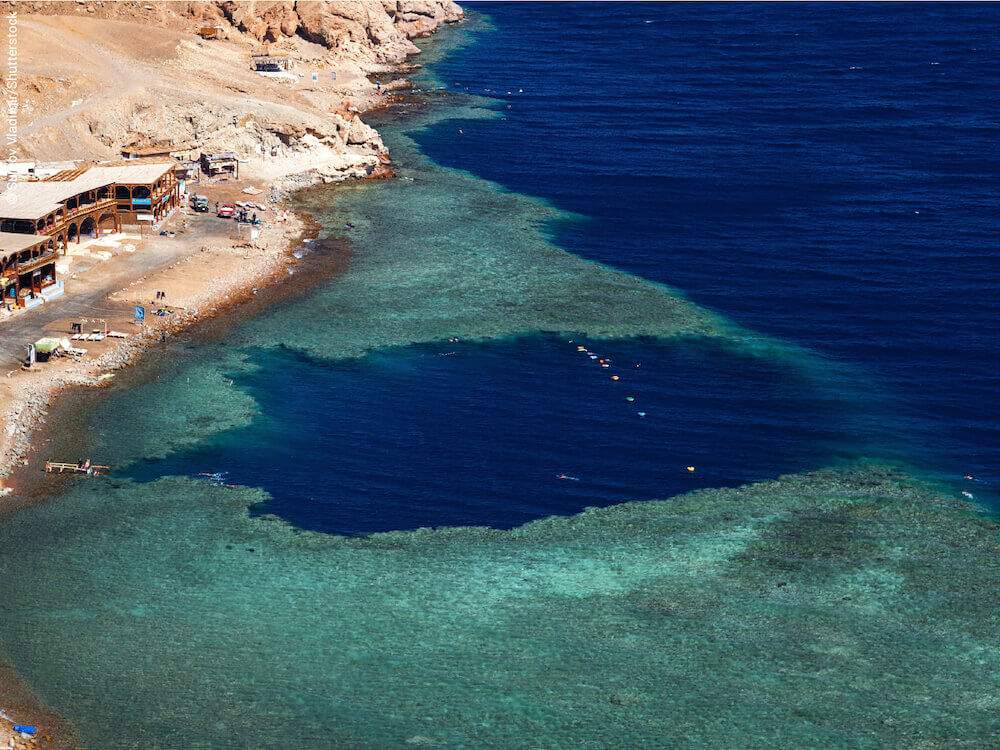
4.) The Blue Hole
Dahab, Egypt
Expect to see: coral, cave, reef fish, parrotfish, lionfish, barracuda, grouper, catfish, eel, octopus
The Blue Hole in Egypt is the second deepest in the world and is 394 feet (120 m) deep. Tourists come from all over to dive this blue hole.
At 184 feet deep there is a horizontal 85 foot (26 m) long tunnel that leads to the open sea. This spot is called The Arch and is famously known as an extreme dive that has resulted in many deaths. Anyone who attempts to go through The Arch must be specially trained as a technical diver first.
The site is best explored by advanced divers who have a high level of both skill and confidence. Many underestimate the extreme depths which is when trouble can occur. Freedivers, snorkelers, and swimmers are welcome at the hole as well.
The wonderful part of this blue hole is that it’s a shore dive. Gear up, walk out to the water, and begin to descend. It’s wonderfully easy to access. The water is calm and clear with amazing visibility.
Don’t expect an overpowering number of fish or coral formations. The main lure is its easy access and the fact that it’s been declared one of the world’s most dangerous dive sites. You might think that would scare divers however it seems to have had the opposite effect.
There have been several hundred deaths at this site however they were almost all due to inexperienced divers pushing too far past their own limits. The hole is very deep and divers can become disoriented if they do not correctly monitor depth levels.
It’s important to have buoyancy control as it’s easy to underestimate the depth and descend too quickly. Nitrogen narcosis is a huge risk factor so always remain aware of depth and stay close to your buddy.
Safety protocols have been set in place and a guard at the site checks to ensure that every diver or dive group is accompanied by a certified instructor.

3.) Andros Island Blue Holes
Andros Island, Bahamas
Expect to see: caves, swim-throughs, coral, tropical fish, shrimp, lobster, crabs
The Andros Islands in the Bahamas is a treasure trove of blue holes. There are over 175 on land and 50 off the shores of the island. Only 10% of the holes have been explored.
These blue holes are part of a massive underground cave system that began forming thousands of years ago. Some of them connect to each other, some are dead ends, and some lead to caves both big and small.
Notable and more challenging holes in the region include South Bright, Benjamin’s Blue Hole, Exley’s Boiling Hole, Lusca’s Breath Blue Hole. 4 Sharks Blue Hole leads to the largest underwater cavern in the Bahamas.
Atlantis Blue Hole is lined with a beautiful reef system when tons of fish, crabs, and lobsters.
Stargate Blue Hole is located on land and is massive and includes huge limestone formations and passageways. It’s famous for its stalactites and the National Geographic documentary filmed here. The hole is located near Congo Town.
Guardian Blue Hole was named the world’s deepest blue hole in 1994. That title has long been overthrown but measuring in at a depth of 436 feet (133 m) is still quite impressive.
You can also visit Blue Holes National Park which sits on 40,000 acres of land and houses 22 blue holes, freshwater reservoirs, and forests. There are plenty of walking trails, pathways, and boardwalks to suit everyone. Admission into the park is free and there are public restrooms available.
You can scuba dive the holes at the Blue Holes National park. Some of these are massive and include El Dorando Blue Hole, Cousteau’s Blue Hole, Captain Bills Blue Hole.
There is always an element of danger when cave diving. If going alone, make certain you are qualified and have adequate training. Otherwise, simply organize a trip with a local dive shop.
There are so many options when diving Andros but the best holes are found on the southern section of the island.
To reach the site you must travel by boat for 55-70 minutes as it’s 30 miles (48 km) northwest of Koror.
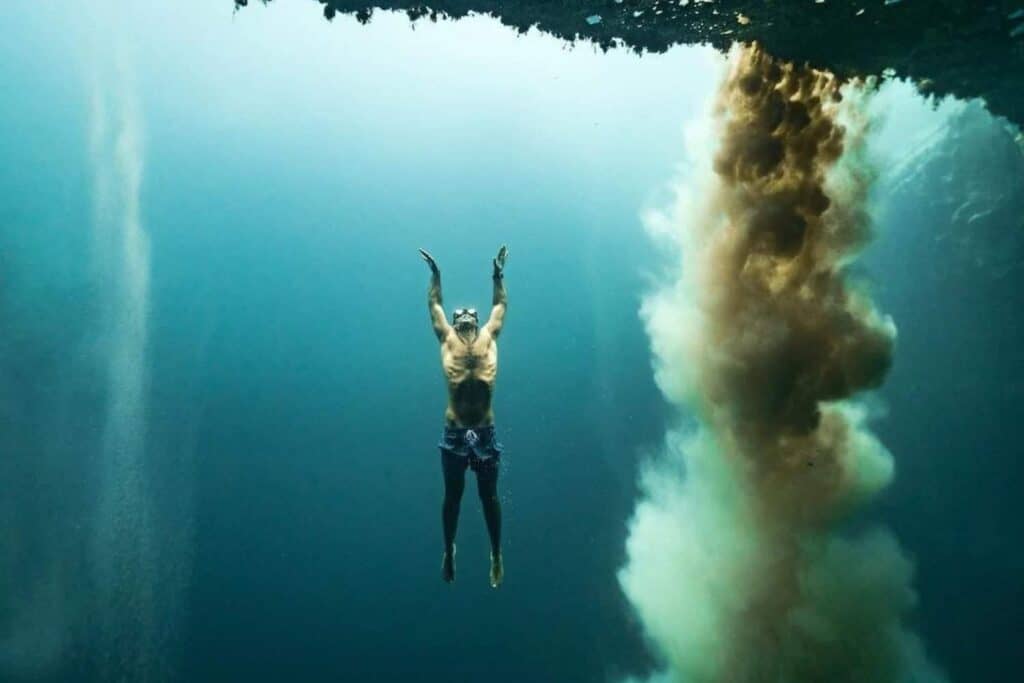
2.) Dean’s Blue Hole
Clarence Town, Long Island, Bahamas
Expect to see: snapper, turtles, seahorses, rays, tropical fish, sandfall, cavern
Dean’s Blue Hole is the second deepest blue hole on earth at 663 feet (202 m) deep. It’s incredibly easy to access with a parking lot nearby and a sandy beach at the entrance of the water.
On the surface, Dean’s is only about 100 feet (30 m) wide in diameter. However, once below the surface at 60 feet (18 m) and at the entrance of the sinkhole, it widens to over 330 feet (101 m) in diameter.
The most unique aspect of Dean’s is that there is something called ‘sandfall‘. As we know, blue holes are sinkholes with entry points below the surface of the water.
At Dean’s Hole, there is sand that continuously falls from the upper section into the hole below. It looks like a waterfall only with sand instead. Additionally, this might be the only location in the world where ‘sandfall’ occurs.
There is a wonderful array of marine life at Dean’s Hole including lots of tropical fish, turtles, and seahorses. Since it is a popular tourist location it can get busy. A portion of the fish tends to scatter when it gets really busy. For the best experience, go early in the morning.
More diving in the Bahamas HERE.
The waters are warm, clear and there is no current. Visibility is usually 80-110 feet (24-30 m) but has been known to get up to 115 feet (35 m). Swimmers and snorkelers are more than welcome to explore the site as well. It’s located directly off a beautiful beach coastline.
An annual freediving competition (Vertical Blue International Freediving Competition) takes place here which attracts a huge crowd of both competitors and spectators. Several world records for freediving have been set right here at Dean’s Hole.
There are many reasons sinkholes occur and Dean’s Hole is said to be caused by erosion.
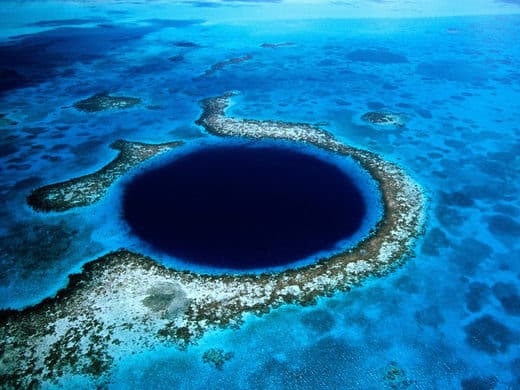
1.) The Great Blue Hole
Belize City, Belize
Expect to see: Caribbean reef shark, bull shark, grouper, parrotfish, tropical fish, shrimp, coral, sea fans
Here we have the widest blue hole currently known and measures 1,043 feet (318 m) wide and 410 feet (125 m) deep. Visibility is amazing and there are lots of coral and marine life. The deeper you go the more interesting it gets with rock formations and stalactites.
The Great Blue Hole is located 60 miles (97 km) off the coast of Belize along Lighthouse Reef. The region is a protected UNESCO World Heritage Site.
There is a huge array of marine life at the site including several species of sharks. Hammerheads are occasionally spotted but not common. Many species of coral can be found including tube and brain along with sea fans.
The best time to go is April-June when visibility is at its peak and whale sharks frequent the area.
The entrance to the sinkhole is around 40 feet (12 m) below the surface. Advanced certified divers can go down to 110-130 feet (34 – 40 m) deep to see stalactites suspended from an overhang. Some of the stalactites are as long as 40 feet (12 m).
While diving the Great Blue Hole in Belize is a lifetime opportunity, it is difficult to reach. The boat ride takes 3-4 hours and goes through rough seas. It’s common for most people to get seasick along the way.
The hole began forming over 153,000 years ago as a cave. Rising sea levels at the end of the last Ice Age (10,000 years ago) flooded many caves in the Caribbean including the Great Blue Hole of Belize. In 2018, submarines used sonar to map the entire hole and were able to construct a 3-D map of nearly all of the hole.
Blue Holes Currently Closed To Tourism
Dragon Hole (Sansha Yongle Blue Hole)
China
Off the coast of China lays the deepest oceanic blue hole in the world. It was discovered by a local fisherman and is 987 feet (301 m) deep. The hole is located off the coast of the Paracel Islands in the South China Sea.
At least 20 new species of fish have been documented with more to come since research has only just begun.
There is no oxygen below 330 feet (101 m) deep so the majority of research is being done using robots and sonar.
There is no telling whether or not the hold will ever be open to the public. It is in a remote location and research here is still ongoing.
Gaskell’s Blue Hole
Australia
Discovered in 2017 when marine biologist Johnny Gaskell was looking at Google Maps. He quickly gathered a team and journeyed 10 hours by boat to dive the hole.
Just 49-66 feet (15-20 m) below the surface are massive coral formations. Reef systems so huge and delicate that they are the most impressive that Johnny has ever seen. This is coming from a marine biologist by the way.
All we know is that the hole is off the coast of the Whitsundays because Johnny and his team are currently keeping the exact location a secret. Johnny claims that he wants to preserve the site for as long as possible and have the opportunity to study it further.
Since this discovery, Johnny has uncovered 3 more blue holes. No word yet as to the locations of those holes either.

